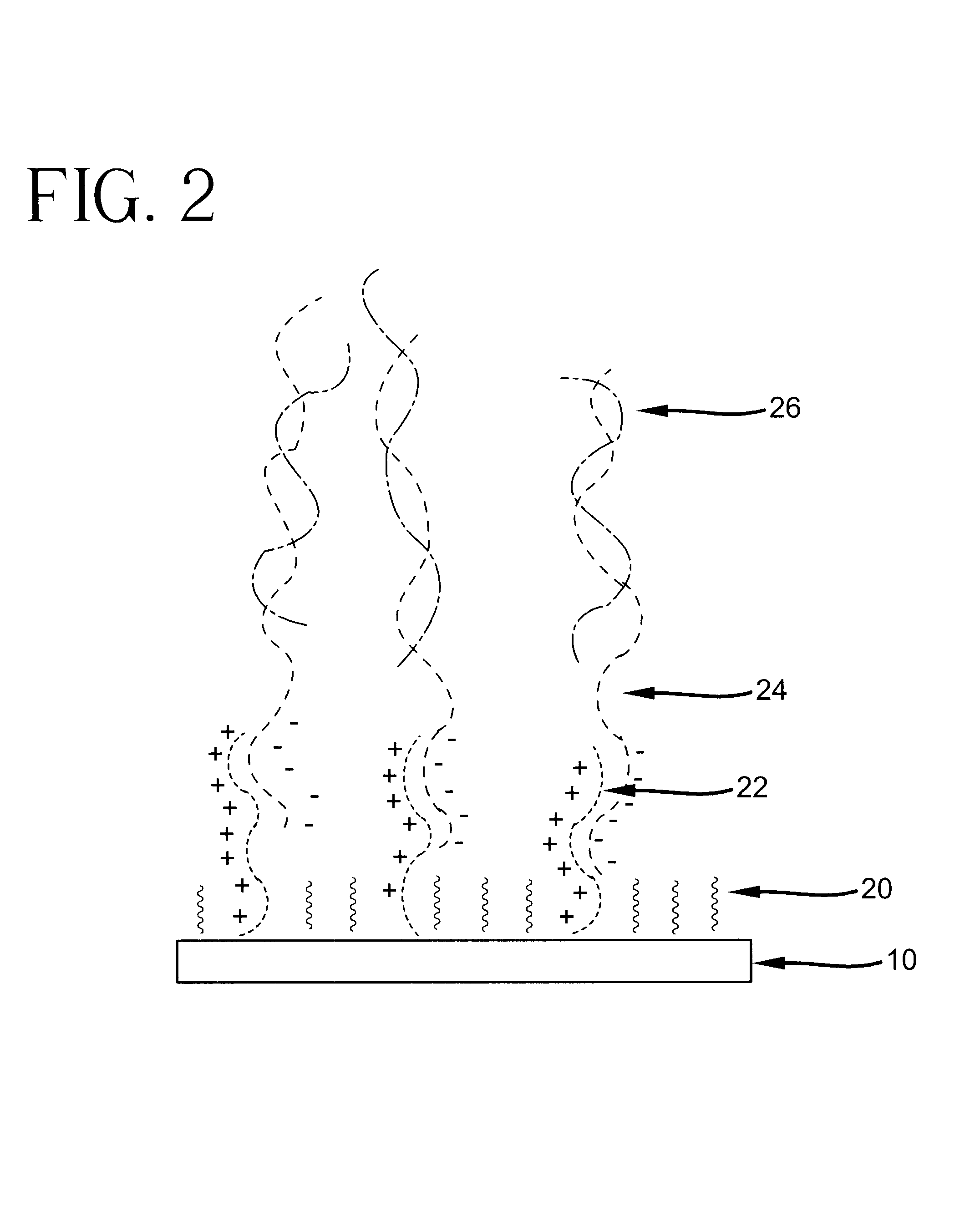Polymer support for DNA immobilization
- Summary
- Abstract
- Description
- Claims
- Application Information
AI Technical Summary
Benefits of technology
Problems solved by technology
Method used
Image
Examples
example 2
Covalent Attachment of DNA through Chemical Modification
This example demonstrates the hybridization efficiency of a substrate prepared through reactive group modifications of the polylysine molecule.
A single soda lime glass slide was cleaned in 1M KOH solutions for 0.5 hour. After cleaning, the slide was rinsed in copious amounts of 18-ohm water and soaked in pure ethanol for 0.5 hour, and dried with nitrogen. Next, the slide was soaked in a silane solution consisting of 5% GIPS in isopropyl alcohol for approximately 2 hours in a humid chamber. The slide was then removed, briefly rinsed with isopropanol and deionized water respectively, and dried with nitrogen gas.
A bath of polylysine(7.5 kD) / ethanolmine in 10 mM sodium phosphate buffer (pH 9.5-10.0) was prepared in a molar ratio of 1:120. The slide was then immersed in the bath solution for 45 minutes, rinsed in deionized water and dried with nitrogen gas.
Carboxylic acid functionalities were created by immersing the slide into to a...
example 3
Influence of Molecular Weight of Polylysine on Soda Lime Glass and Porous glass.
This example demonstrates by means of fluorescent false color imaging the influence of the molecular weight of polylysine in DNA hybridization experiments over several substrates.
The substrates used in this example were soda-lime glass microscope slides (Erie Scientific. Portsmouth. N.H.) and porous glass slides (Vycor.TM., Corning Inc., Coming. N.Y.). The four slides used for the experiment, two of each substrate material, were prepared in the following manner:
The slides were cleaned in 1M KOH solutions for 0.5 hour. After cleaning, the slides were rinsed in copious amounts of 18-ohm water and soaked in pure ethanol for 0.5 hour, and dried with nitrogen. Next, the slides were soaked in a silane solution consisting of 5% GIPS in isopropyl alcohol for approximately 2 hours in a humid chamber. The slides were then removed, briefly rinsed with isopropanol and deionized water respectively, and dried with nit...
example 4
Effect of DNA Concentration on Hybridization
This example demonstrates the DNA loading capacity of a substrate of the present invention over various DNA concentrations.
Soda lime glass slides were cleaned in 1M KOH solutions for 0.5 hour. After cleaning, the slides were rinsed in copious amounts of 18-ohm water and soaked in pure ethanol for 0.5 hour, and dried with nitrogen. Next, the slides were soaked in a silane solution consisting of 5% GIPS in isopropyl alcohol for approximately 2 hours in a humid chamber. The slides were then removed, briefly rinsed with isopropanol and deionized water respectively, and dried with nitrogen gas.
A bath of polylysine(7.5kD) / ethanolmine in 10 mM sodium phosphate buffer (pH 9.5-10.0) was prepared in a molar concentration of approximately 1:120. The slides were then immersed the bath solution for 45 minutes, rinsed in deionized water, and dried with nitrogen gas.
Probes in the form of 1.5 kb fragments of double stranded DNA at different concentrations...
PUM
| Property | Measurement | Unit |
|---|---|---|
| Molar density | aaaaa | aaaaa |
| Molar density | aaaaa | aaaaa |
| Molar density | aaaaa | aaaaa |
Abstract
Description
Claims
Application Information
 Login to View More
Login to View More - R&D
- Intellectual Property
- Life Sciences
- Materials
- Tech Scout
- Unparalleled Data Quality
- Higher Quality Content
- 60% Fewer Hallucinations
Browse by: Latest US Patents, China's latest patents, Technical Efficacy Thesaurus, Application Domain, Technology Topic, Popular Technical Reports.
© 2025 PatSnap. All rights reserved.Legal|Privacy policy|Modern Slavery Act Transparency Statement|Sitemap|About US| Contact US: help@patsnap.com



